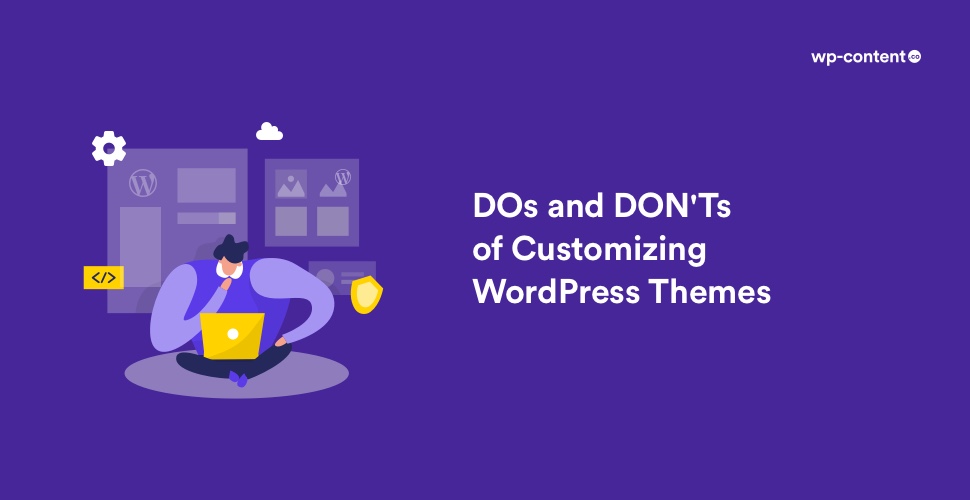You may have felt certain WordPress themes would be apt for your website, but there would be instances when you feel it is not enough. There are plenty of themes available in the WordPress repository, but instead of changing the theme, you can always customize WordPress themes! All you need to know is the right way to do it. We would like to take you through the Dos and Don’ts of customizing WordPress themes. But before that, let us give you some basics.
What are WordPress Themes?
WordPress themes are a collection of predesigned templates that collectively define the overall appearance of your website. The theme controls almost every aspect of your site including header, footer, colours and layouts. For all niches, there are thousands of WordPress themes available, some for free, while others are premium. You can choose an appropriate theme from the repository and set up your website without much hassle.
Why Customize Your WordPress Themes
The basic need to customize your WordPress theme is to give a unique style and look to your website. As mentioned earlier, there are thousands of themes available, and many brands would be using the same theme for their sites. Also, no theme is 100% perfect, to provide you with everything you are looking for. Hence, customizing your WordPress theme could bring some uniqueness, make the site different from others and also help you stand out from the crowd.
Now let’s see what are the Do’s and Don’ts while customizing WordPress Themes.
DOs
1. Create Child Themes to Make Modifications
While customizing your theme, creating a child theme helps your site from losing any data. You can add snippets and custom codes to your child theme, and it will stay there, with no data loss. The child theme file actually has all the functions and features the same as the parent theme, but WordPress reads archive.php of the child theme only. Hence, it is wise to work on the child theme if you want to customize WordPress themes, rather than the original theme itself.
2. Follow the Theme Documentation to Customise It
Every theme comes with documentation that would have clearly mentioned where customization can be done. If you want to change the background colour or font or layout, you can refer to this documentation if you are customising the theme file directly. Otherwise, chances of losing the data whenever there is an update are high and you will have to start from scratch.
3. Make Use of The Power of Default Customizer
If you have noticed, there is a ‘Customize’ option in the ‘Appearance’ section in your dashboard. This is the default customizer of your theme and each theme will have different customization options where you could make the changes according to your requirements with out affecting the theme file. This is in fact a straightforward way to make changes to your WordPress theme.
4. Test the Site on Different Browsers and Screens
Before launching your website, it is always a good idea to test it on different browsers and screens in order to retain all potential leads. Even though Google Chrome comes with a market share of 64.04%, you shouldn’t take chances and test the site on all the top players in the field. The same goes for screens – you must test the site and confirm that your WordPress theme is compatible on all devices including mobile phones, tablets, laptops and desktops. If your theme isn’t compatible with a potential customer or investor’s device or browser, the loss you may face would not be comprehensible.
5. Take Backup Before Making Any Changes
Every time you intend to customize or make any changes to your WordPress theme, always remember to take backup. There are various backup solutions available that you could consider before entering the task. This process is important because if you fail to take backup, the chances of losing data are high especially when there is an unexpected mistake or crash. So, always remember to take backup.
6. Keep the Theme Updated
It is extremely important to keep your theme updated as a non-updated file is more vulnerable to external attacks. Every new update will have a fix to the problems in the previous version as well. Hence, it is always advisable to update your theme even if you are customising it.
DON’Ts
1. Edit Any Theme Files
Editing your theme file directly is a very bad idea as it could cause many security vulnerabilities along with other issues. If you edit a theme file, there is a higher chance of data loss once you update the theme as well. Also, editing the theme directly could even end up crashing your entire site.
2. Insert Code from Unknown Sources
When you are looking to solve an issue, you will find quite a few recommended solutions from various sources. These are however risky to use as they are mostly codes that might be posted even by hackers. These codes have the potential to steal your data and crash your site. So it is always wise to stay away from codes from unknown sources.
3. Install ‘Nulled’ Themes
Nulled themes are pirated copies of premium WordPress themes that are distributed on the internet by third party websites. These themes once installed would work perfectly but they may have malware, scripts to steal your data or crash your website. It is like a time bomb and would explode when you least expect it. Hence, never install nulled themes and save your website from crashing.
4. Edit the CSS
If you are someone who isn’t well aware of the WordPress system, in order to make changes, your first instinct would be to edit the CSS file. Editing the original CSS file is similar to editing the theme – you could lose data once an update happens. If you want to edit the CSS, check for additional CSS instead and make your changes there.
5. Override the Entire Template if Hooks Exist
There are themes that support hooks – hooks are a way for one piece of code to interact/modify another piece of code at specific, pre-defined spots. These hooks would allow you to change the content of the theme without overriding the entire theme template in the child theme. So, if hooks exist, you don’t need to override the theme template especially when there is an update.
6. Skip Using the Local Testing Server
It is always better to test your theme and site on a local testing server before going live. This would be a replica of your site and you will get to know what all changes need to be applied on the original site without disrupting it.
Wrapping Up
While most WordPress themes are capable enough to make your site functional, you can always customize it to make it unique. However, do keep the said points in mind before you take the plunge, and you will not regret it!


